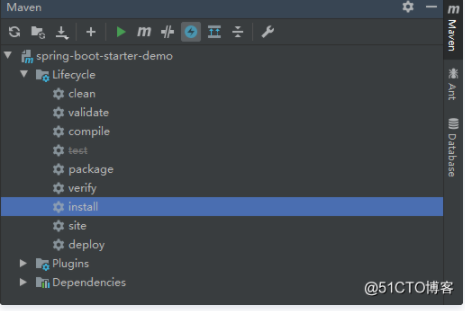关于Starter
Spring Boot秉承“约定大于配置”的开发方式,使得我们基于Spring Boot开发项目的效率变得十分高。
相信使用过Spring Boot的小伙伴都会发现,当我们要用到某个Spring提供的组件时,只需要在pom.xml文件中添加该组件的starter依赖就能集成到项目中。
例如,在pom.xml文件中添加spring-boot-starter-web依赖,就能让项目整合Spring MVC的功能。
并且在最简使用下几乎不需要进行任何的配置,而以往想要集成Spring MVC,不仅要添加一堆类似于spring-web、spring-webmvc等相关依赖包,以及完成许多繁杂的配置才能够实现集成。
这是因为starter里已经帮我们整合了各种依赖包,避免了依赖包缺失或依赖包之间出现版本冲突等问题, 以及完成了许多基础配置和自动装配,让我们可以在最简使用下,跳过绝大部分的配置,从而达到开箱即用的效果。
这也是Spring Boot实现“约定大于配置”的核心之一。
动手开发一个Starter
通过以上的描述,我们可以简单地将starter看作是对一个组件功能粒度较大的模块化封装,包括了所需依赖包的整合及基础配置和自动装配等。
除了Spring官方提供的starter外,我们自己也可以根据业务开发一个starter。例如,当项目积累到一定程度时,我们可以将一些通用功能下沉为一个starter。
而开发一个starter也很简单,只需要以下步骤:
- 新建一个Maven项目,在pom.xml文件中定义好所需依赖;
- 新建配置类,写好配置项和默认值,使用
@ConfigurationProperties指明配置项前缀; - 新建自动装配类,使用
@Configuration和@Bean来进行自动装配; - 新建
spring.factories文件,用于指定自动装配类的路径; - 将starter安装到maven仓库,让其他项目能够引用;
接下来,以封装一个用于操作redis的starter为例,一步步展示这些步骤的具体实现过程。
首先是第一步,新建一个maven项目,完整的pom.xml内容如下:
<?xml version="1.0" encoding="UTF-8"?> <project xmlns="http://maven.apache.org/POM/4.0.0" xmlns:xsi="http://www.w3.org/2001/XMLSchema-instance" xsi:schemaLocation="http://maven.apache.org/POM/4.0.0 https://maven.apache.org/xsd/maven-4.0.0.xsd"> <modelVersion>4.0.0</modelVersion> <parent> <groupId>org.springframework.boot</groupId> <artifactId>spring-boot-starter-parent</artifactId> <version>2.2.0.RELEASE</version> <relativePath/> <!-- lookup parent from repository --> </parent> <groupId>com.example</groupId> <artifactId>spring-boot-starter-demo</artifactId> <version>0.0.1-SNAPSHOT</version> <name>spring-boot-starter-demo</name> <description>Demo project for Spring Boot</description> <properties> <java.version>1.8</java.version> </properties> <dependencies> <dependency> <groupId>org.springframework.boot</groupId> <artifactId>spring-boot-starter</artifactId> </dependency> <dependency> <groupId>org.springframework.boot</groupId> <artifactId>spring-boot-configuration-processor</artifactId> <optional>true</optional> </dependency> <dependency> <groupId>org.projectlombok</groupId> <artifactId>lombok</artifactId> <optional>true</optional> </dependency> <dependency> <groupId>org.springframework.boot</groupId> <artifactId>spring-boot-starter-test</artifactId> <scope>test</scope> <exclusions> <exclusion> <groupId>org.junit.vintage</groupId> <artifactId>junit-vintage-engine</artifactId> </exclusion> </exclusions> </dependency> <!-- jedis --> <dependency> <groupId>redis.clients</groupId> <artifactId>jedis</artifactId> <version>3.1.0</version> </dependency> <!-- gson --> <dependency> <groupId>com.google.code.gson</groupId> <artifactId>gson</artifactId> <version>2.8.6</version> </dependency> </dependencies> </project>
第二步,新建一个属性配置类,写好配置项和默认值。并使用@ConfigurationProperties指明配置项前缀,用于加载配置文件对应的前缀配置项:
package com.example.starter.demo.properties; import lombok.Data; import org.springframework.boot.context.properties.ConfigurationProperties; /** * 属性配置类,用于加载配置文件对应的前缀配置项 * * @author zero * @date 2019-11-04 **/ @Data @ConfigurationProperties("demo.redis") public class RedisProperties { private String host = "127.0.0.1"; private int port = 6379; private int timeout = 2000; private int maxIdle = 5; private int maxTotal = 10; private long maxWaitMillis = 10000; private String password; }
编写一个简单的redis操作工具,代码如下:
package com.example.starter.demo.component; import com.google.gson.Gson; import lombok.RequiredArgsConstructor; import lombok.extern.slf4j.Slf4j; import redis.clients.jedis.Jedis; import redis.clients.jedis.JedisPool; /** * redis 操作组件 * * @author zero * @date 2019-11-04 **/ @Slf4j @RequiredArgsConstructor public class RedisComponent { private final JedisPool jedisPool; /** * get value with key */ public <T> T get(String key, Class<T> clazz) { try (Jedis resource = jedisPool.getResource()) { String str = resource.get(key); return stringToBean(str, clazz); } } /** * set value with key */ public <T> boolean set(String key, T value, int expireSeconds) { try (Jedis resource = jedisPool.getResource()) { String valueStr = beanToString(value); if (valueStr == null || valueStr.length() == 0) { return false; } if (expireSeconds <= 0) { resource.set(key, valueStr); } else { resource.setex(key, expireSeconds, valueStr); } return true; } } private <T> T stringToBean(String str, Class<T> clazz) { Gson gson = new Gson(); return gson.fromJson(str, clazz); } private <T> String beanToString(T value) { Gson gson = new Gson(); return gson.toJson(value); } }
第三步,新建自动装配类,使用@Configuration和@Bean来实现对JedisPool和RedisComponent的自动装配;
package com.example.starter.demo.configuration; import com.example.starter.demo.component.RedisComponent; import com.example.starter.demo.properties.RedisProperties; import lombok.RequiredArgsConstructor; import lombok.extern.slf4j.Slf4j; import org.springframework.boot.autoconfigure.condition.ConditionalOnMissingBean; import org.springframework.boot.context.properties.EnableConfigurationProperties; import org.springframework.context.annotation.Bean; import org.springframework.context.annotation.Configuration; import redis.clients.jedis.JedisPool; import redis.clients.jedis.JedisPoolConfig; /** * 自动装配类 * * @author zero * @date 2019-11-04 **/ @Slf4j @Configuration @RequiredArgsConstructor @EnableConfigurationProperties(RedisProperties.class) public class RedisConfiguration { private final RedisProperties properties; @Bean // 表示当Spring容器中没有JedisPool类的对象时,才调用该方法 @ConditionalOnMissingBean(JedisPool.class) public JedisPool jedisPool() { log.info("redis connect string: {}:{}", properties.getHost(), properties.getPort()); JedisPoolConfig jedisPoolConfig = new JedisPoolConfig(); jedisPoolConfig.setMaxIdle(properties.getMaxIdle()); jedisPoolConfig.setMaxTotal(properties.getMaxTotal()); jedisPoolConfig.setMaxWaitMillis(properties.getMaxWaitMillis()); String password = properties.getPassword(); if (password == null || password.length() == 0) { return new JedisPool(jedisPoolConfig, properties.getHost(), properties.getPort(), properties.getTimeout()); } return new JedisPool(jedisPoolConfig, properties.getHost(), properties.getPort(), properties.getTimeout(), properties.getPassword()); } @Bean @ConditionalOnMissingBean(RedisComponent.class) public RedisComponent redisComponent(JedisPool jedisPool){ return new RedisComponent(jedisPool); } }
第四步,在项目的resources目录下新建一个META-INF目录,并在该目录下新建spring.factories文件。
如下图所示:

在spring.factories文件里指定自动装配类的路径:
org.springframework.boot.autoconfigure.EnableAutoConfiguration=\
com.example.starter.demo.configuration.RedisConfiguration
若需要指定多个自动装配类的路径,则使用逗号分隔。如下示例:
org.springframework.boot.autoconfigure.EnableAutoConfiguration=\
com.example.starter.demo.configuration.DemoConfiguration,\
com.example.starter.demo.configuration.RedisConfiguration
Tips:spring.factories支持配置的key如下
org.springframework.context.ApplicationContextInitializer
org.springframework.context.ApplicationListener
org.springframework.boot.autoconfigure.AutoConfigurationImportListener
org.springframework.boot.autoconfigure.AutoConfigurationImportFilter
org.springframework.boot.autoconfigure.EnableAutoConfiguration
org.springframework.boot.diagnostics.FailureAnalyzer
org.springframework.boot.autoconfigure.template.TemplateAvailabilityProvider
org.springframework.boot.env.EnvironmentPostProcessor
org.springframework.boot.SpringApplicationRunListener
org.springframework.boot.SpringBootExceptionReporter
org.springframework.beans.BeanInfoFactory
org.springframework.boot.env.PropertySourceLoader
org.springframework.data.web.config.SpringDataJacksonModules
org.springframework.data.repository.core.support.RepositoryFactorySupport
最后install这个maven项目,命令如下:
mvn clean install
如果使用的开发工具是IDEA的话就比较简单,只需要双击一下install即可:

使用Starter
在任意一个Spring Boot项目的pom.xml文件中添加如下依赖:
<dependency>
<groupId>com.example</groupId>
<artifactId>spring-boot-starter-demo</artifactId>
<version>0.0.1-SNAPSHOT</version>
</dependency>
在项目的application.yml中添加如下配置项来覆盖默认配置,若默认配置已符合需求则可以省略这一步:
demo: redis: host: 192.168.11.130 port: 6379 timeout: 3000 password: A8^MZ59qOr*gkhv51tSdifvb max-total: 10 max-wait-millis: 10000 max-idle: 10
编写一个单元测试类进行测试,代码如下:
package com.example.firstproject.starter; import com.example.starter.demo.component.RedisComponent; import lombok.extern.slf4j.Slf4j; import org.junit.Test; import org.junit.runner.RunWith; import org.springframework.beans.factory.annotation.Autowired; import org.springframework.boot.test.context.SpringBootTest; import org.springframework.test.context.junit4.SpringRunner; @Slf4j @SpringBootTest @RunWith(SpringRunner.class) public class StarterTests { @Autowired private RedisComponent redisComponent; @Test public void redisTest() { String key = "redisTest"; String value = "this is a test value"; boolean success = redisComponent.set(key, value, 3600); log.info("set value to redis {}!", success ? "success" : "failed"); String result = redisComponent.get(key, String.class); log.info("get value from redis: [{}]", result); } }
运行结果如下:

附代码仓库地址:
https://gitee.com/demo_focus/Spring-Boot-Starter-Demo
转发:https://cloud.tencent.com/developer/article/1702341